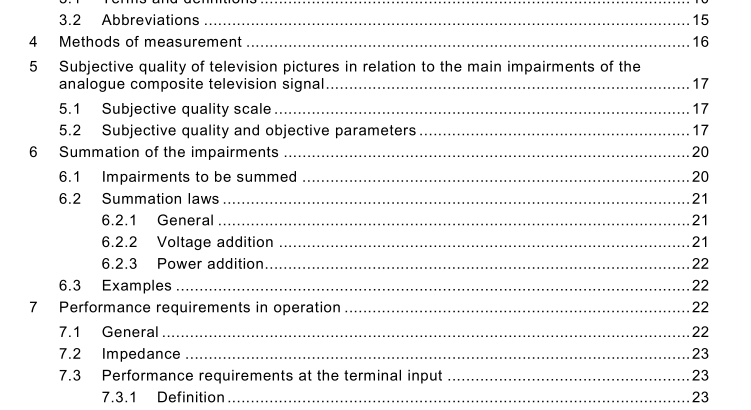IEC 60728-1-2:2009 pdf download – Cable networks for television signals, sound signals and interactive services – Part 1-2: Performance requirements for signals delivered at the system outlet in operation
1 scope
This part of lEC 60728 provides the minimum performance requirements to be fulfilled inoperation at the system outlet or terminal input and describes the summation criteria for theimpairments present in the received signals and those produced by the CATVI/MATVISMATVcable network, including individual receiving systems.
NOTE 1 When a change of signal format is made at the headend,the summation of the impairments does notapply (see also Clause 7y
In a building divided into apartment blocks,the signals received by the antennas aredistributed by the MATVISMATV cable network up to the home network interface (HNI); thetelevision signals are then distributed (inside the home) by home networks (HN) of varioustypes up to the system outlet or terminal input. The cable network can support two wayoperation, from the system outlet(or terminal input) towards the headend.
The home network can use coaxial cables,balanced pair cables, fibre optic cables (glass orplastic) and also wireless links inside a room (or a small number of adjacent rooms) to replacewired cords.
This part of lEC 60728 is applicable to cable networks intended for television signals,soundsignals and interactive services operating between about 5 MHz and 3 000 MHz. Thefrequency range is extended to 6 000 MHz for home distribution techniques that replace wiredcords with a wireless two way communication inside a room (or a small number of adjacentrooms) that uses the 5 GHz to 6 GHz frequency band.
Figure 1 shows the main sections of a general CATV/MATVISMATV system,indicating theparts of the lEC 60728-1 series documents where the relevant performance requirements areindicated.
. The requirements for the signals received at the headend are given in Clause 6 oflEC 60728-1.
. The requirements for the CATV/MATVISMATV cable network,assuming an unimpaired
input signal at the input of the headend, up to the system outlet are given in lEC 60728-1,Clause 5.
The requirements for the CATV/MATVISMATV cable network up to the home networkinterface (HNI) are given in lEC 60728-1,Clause 7, assuming an unimpaired input signalat the input of the headend.
. The specific requirements from HNl to the system outlet or terminal input are given inIEC 60728-1-1,Clause 5, assuming an unimpaired input signal at the HNl.
. The requirements at the system outlet in operation are given in Clause 7 of this standard.The expression “in operation” means that the received signals,with their impairments,areapplied to the headend input of the CATV/MATVISMATV cable network.The requirements atthe system outlet “in operation”are derived,therefore, by summing the impairments of thevarious cascaded parts of the system and of the input signal.
This standard also provides references for the basic methods of measurement of the operational characteristics of the downstream cable network in order to assess its performance. All requirements refer to the performance limits to be achieved in operation at any system outlet when terminated in a resistance equal to the nominal load impedance of the system, unless otherwise specified. Where system outlets are not used, the above applies to the terminal input.
NOTE 2 If the home network is subdivided into a number of parts, using different transmission media (e.g. coaxial cabling, balanced cabling, optical cabling, wireless links) the accumulation of degradations should not exceed the figures given below.
NOTE 3 Performance requirements of return paths as well as special methods of measurement for the use of the return paths in cable networks are described in IEC 60728-1 0.
2 Normative references The following referenced documents are indispensable for the application of this document. For dated references, only the edition cited applies. For undated references, the latest edition of the referenced document (including any amendments) applies. IEC 60050-705, International Electrotechnical Vocabulary (IEV) – Chapter 705: Radio wave propagation
